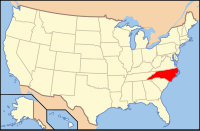Guilford County, North Carolina
| Guilford County, North Carolina | ||
|---|---|---|

Guilford County Courthouse in Greensboro
|
||
|
||
 Location in the U.S. state of North Carolina |
||
 North Carolina's location in the U.S. |
||
| Founded | 1771 | |
| Named for | Francis North, 1st Earl of Guilford | |
| Seat | Greensboro | |
| Largest city | Greensboro | |
| Area | ||
| • Total | 658 sq mi (1,704 km2) | |
| • Land | 646 sq mi (1,673 km2) | |
| • Water | 12 sq mi (31 km2), 1.8% | |
| Population (est.) | ||
| • (2015) | 517,600 | |
| • Density | 792.7/sq mi (306/km²) | |
| Congressional districts | 6th, 12th | |
| Time zone | Eastern: UTC-5/-4 | |
| Website | www |
|
Guilford County is a county located in the U.S. state of North Carolina. As of the 2010 census, the population was 488,406, making it the third-most populous county in North Carolina. Its seat is Greensboro. Since 1938, an additional county court has been located in High Point, North Carolina. The county was formed in 1771.
Guilford County is included in the Greensboro-High Point, NC Metropolitan Statistical Area, which is also included in the Greensboro-Winston-Salem-High Point, NC Combined Statistical Area.
At the time of European encounter, the inhabitants of the area that became Guilford County were a Siouan-speaking people called the Saura. Beginning in the 1740s, settlers arrived in the region in search of fertile and affordable land. These first settlers included American Quakers from Pennsylvania, Maryland, and New England at what is now Greensboro, as well as German Reformed and Lutherans in the east, British Quakers in the south and west, and Scotch-Irish Presbyterians in the center of today's Guilford County. As population increased, the North Carolina colonial legislature organized the county in 1771, from parts of Rowan and Orange counties. It was named for Francis North, Earl of Guilford, father of Frederick North, Lord North, British Prime Minister from 1770 to 1782.
...
Wikipedia

